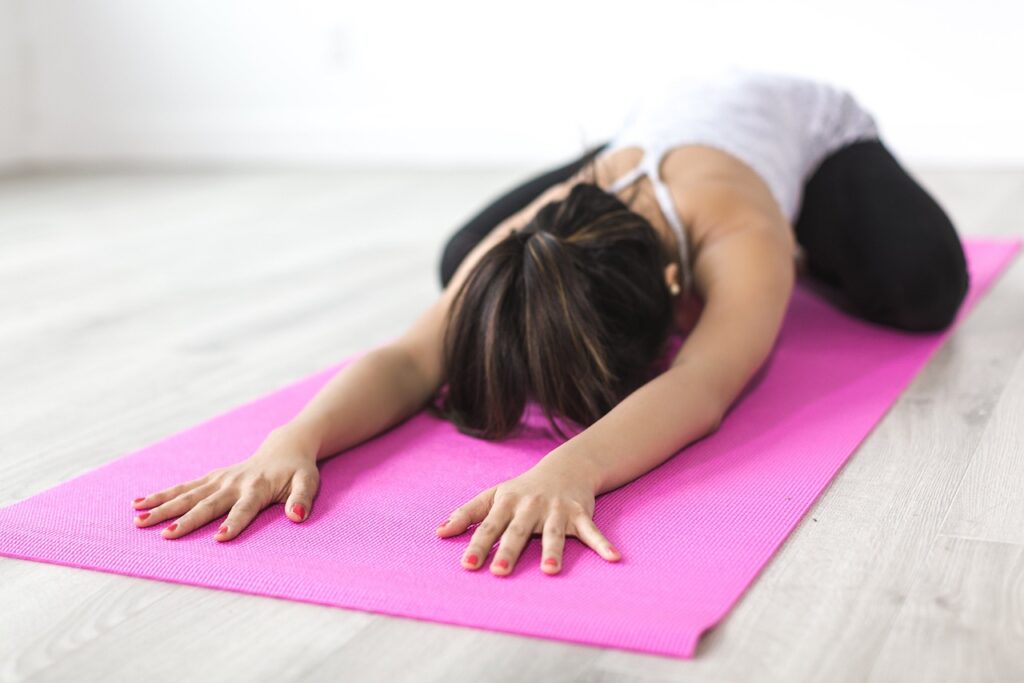Whether you’re a seasoned athlete or just starting out on your fitness journey, the question of whether stretching before exercise is necessary has likely crossed your mind. We’ve all heard the conflicting opinions – some swear by the benefits of stretching as a warm-up, while others argue it’s simply a time-consuming ritual with no real impact. In this article, we’ll explore the science behind stretching and shed light on the age-old debate, helping you make an informed decision about your pre-workout routine. So, is stretching before exercise truly necessary? Let’s find out.

This image is property of pixabay.com.
What is stretching?
Stretching refers to the deliberate movement or extension of muscles, tendons, and other soft tissues to increase their flexibility or lengthen them. It is a widely practiced activity that is often performed before exercise to prepare the body for physical activity. Stretching is an essential component of any fitness routine, as it helps improve flexibility, joint range of motion, and athletic performance.
Definition of stretching
Stretching is the process of intentionally elongating muscles, tendons, and other soft tissues to increase their range of motion. It involves moving the body into specific positions to stretch and lengthen the targeted muscles. Stretching can be done in many different ways, including static stretching, dynamic stretching, PNF stretching, and ballistic stretching.
Types of stretching
There are several types of stretching exercises that individuals can incorporate into their exercise routines. These include:
-
Static stretching: This involves stretching a muscle to its furthest point and then holding that position for an extended period. It is commonly done by slowly stretching a muscle and holding the stretch for about 15-60 seconds.
-
Dynamic stretching: Dynamic stretching involves moving parts of the body through a full range of motion in a controlled manner. This type of stretching is often done before exercise to warm up the body and increase blood flow to the muscles.
-
PNF stretching: PNF stretching, or proprioceptive neuromuscular facilitation stretching, involves alternating between contraction and relaxation of the target muscle group. It is typically done with the help of a partner or a prop to maximize the stretch.
-
Ballistic stretching: Ballistic stretching involves using momentum to stretch muscles beyond their normal range of motion. It typically involves bouncing or jerking movements, which can be more intense and may carry a higher risk of injury if not done properly.
Benefits of stretching before exercise
Increased flexibility
One of the key benefits of stretching before exercise is increased flexibility. Regular stretching helps improve the elasticity of muscles and tendons, allowing them to move more freely. This increased flexibility can enhance overall performance during exercise and help prevent injuries. By increasing the range of motion in your joints, stretching before exercise enables you to move more easily and with greater efficiency.
Improved joint range of motion
Stretching before exercise can also improve joint range of motion. When you stretch, you are actively working to maintain or increase the flexibility of your joints. By doing so, you are allowing your joints to move more freely and with less restriction. This improved range of motion can help you perform exercises with better form and precision, reducing the risk of joint-related injuries.
Enhanced athletic performance
Stretching before exercise has been shown to enhance athletic performance. When you stretch your muscles before engaging in physical activity, you increase blood flow to those muscles, delivering more oxygen and nutrients. This increased blood flow not only improves muscle performance but also helps to warm up the body and prepare it for the demands of exercise. By stretching before exercise, you can optimize your physical performance and maximize your overall workout experience.
Controversies surrounding stretching before exercise
While stretching before exercise is commonly practiced, there are some controversies surrounding its effectiveness and potential adverse effects. Here are a few key points to consider:
Conflicting research studies
Research on the benefits and drawbacks of stretching before exercise has yielded conflicting results. Some studies suggest that pre-exercise stretching can reduce the risk of muscle strains and improve performance, while others indicate that static stretching may temporarily decrease muscle strength and power. These conflicting findings make it challenging to draw definitive conclusions about the effects of stretching before exercise.
Potential adverse effects
Another controversy surrounding stretching before exercise is the potential for adverse effects. Some studies suggest that static stretching before exercise can temporarily decrease muscular strength and power output. This reduction in strength and power could potentially impair performance during activities that require explosive movements, such as sprints or jumps. However, the magnitude and duration of these effects may vary among individuals.
Stretching vs. warm-up
Another point of contention is whether stretching should be considered a warm-up or a separate activity. While stretching is often done before exercise, it is important to distinguish between static stretching and dynamic warm-up exercises. Dynamic warm-ups, which involve moving the body through a range of motion, have been shown to be more effective in preparing the body for exercise than static stretching alone.
Types of stretching exercises
To incorporate stretching into your pre-workout routine, you can choose from various stretching techniques. These include:
Static stretching
Static stretching involves holding a stretch for an extended period, usually around 15-60 seconds. It is often done in a relaxed and stationary position, targeting specific muscles. Static stretching is typically done after a workout when the muscles are warm and more pliable.
Dynamic stretching
Dynamic stretching involves moving your body through a full range of motion in a controlled manner. It helps to increase blood flow, warm up the muscles, and improve joint mobility. Dynamic stretches are often performed in a rhythmic and repetitive manner and can include movements like leg swings, arm circles, or walking lunges.
PNF stretching
Proprioceptive Neuromuscular Facilitation (PNF) stretching combines stretching and contracting muscles to improve flexibility. It typically involves contracting a muscle for a few seconds before relaxing and stretching it further. PNF stretching is often done with the help of a partner or a prop to provide resistance and maximize the stretch.
Ballistic stretching
Ballistic stretching involves using momentum to stretch muscles beyond their normal range of motion. It typically incorporates bouncing or jerking movements to achieve a deeper stretch. However, caution should be exercised when performing ballistic stretches, as they can carry a higher risk of injury if not done properly.

This image is property of pixabay.com.
When and how long to stretch before exercise
When and how long you should stretch before exercise depends on various factors, including your individual needs and preferences. However, here are some general recommendations to consider:
Pre-workout warm-up routine
Before engaging in any stretching exercises, it is important to perform a warm-up routine. A warm-up helps to gradually increase your heart rate, improve blood circulation, and warm up your muscles. This can be achieved through activities such as light jogging, cycling, or jumping jacks. A warm-up should typically last for about 5-10 minutes.
Duration of pre-workout stretching
When it comes to the duration of stretching before exercise, it is recommended to spend about 10-15 minutes stretching major muscle groups. This allows adequate time to perform different stretching exercises and prepare your body for the upcoming physical activity.
Stretching after warm-up
Stretching after your warm-up routine can be beneficial for further muscle preparation. This post-warm-up stretching can help improve flexibility, increase joint range of motion, and prevent injury during exercise. It is important to keep in mind that the intensity and duration of these stretches should be gentle and gradually increased.
Alternatives to stretching before exercise
While stretching before exercise is commonly practiced, there are alternatives that individuals can consider incorporating into their pre-workout routine. These alternatives include:
Foam rolling
Foam rolling, also known as self-myofascial release, involves using a foam roller to apply pressure to specific muscles or muscle groups. This technique aims to release muscle tension, improve flexibility, and increase blood flow to the muscles. Foam rolling can be an effective alternative or addition to stretching before exercise.
Mobility exercises
Mobility exercises focus on improving joint and muscle function by moving joints through natural ranges of motion. These exercises often target specific areas of the body and can be beneficial in preparing the body for exercise. Examples of mobility exercises include arm swings, leg swings, and shoulder circles.
Activation exercises
Activation exercises aim to activate and engage specific muscles or muscle groups before exercise. These exercises help to improve muscle recruitment and enhance overall performance. Some examples of activation exercises include glute bridges, clamshells, and band walks.

This image is property of pixabay.com.
Guidelines for stretching before exercise
To ensure a safe and effective stretching routine before exercise, here are some helpful guidelines to follow:
Consulting with a professional
If you are new to stretching or have any specific concerns or health conditions, it is recommended to consult with a professional, such as a physical therapist or qualified fitness instructor. They can provide personalized guidance, assess your individual needs, and recommend appropriate stretching exercises.
Listening to your body
It is important to listen to your body during stretching exercises. Stretching should be performed within your comfort level and should not cause pain. If you feel any discomfort or pain, it is essential to modify the stretch or discontinue it altogether. Pushing yourself too far during stretching can lead to injuries and may be counterproductive.
Stretching techniques and form
Proper stretching techniques and form are crucial to ensure the effectiveness and safety of your stretching routine. When performing stretches, it is important to maintain good posture, breathe deeply and fully, and focus on the targeted muscles. Avoid bouncing or jerking movements, as these can increase the risk of injury.
The importance of individual differences
It is essential to acknowledge the impact of individual differences when it comes to stretching before exercise. Here are some factors to consider:
Body type and flexibility
Individuals have different body types and levels of flexibility. Factors such as genetics, age, and lifestyle can influence one’s flexibility. It is important to respect and work within your own limits to avoid overstretching or causing injury. Gradually increasing the intensity and duration of stretches over time can help improve flexibility safely.
Injury history
If you have a history of injuries, it is essential to take precautions and seek professional guidance when stretching before exercise. Some injuries may require modifications or specific stretching techniques to avoid exacerbating the condition. A professional can provide appropriate exercises and advice based on your injury history.
Specific exercise requirements
Different forms of exercise may require specific stretching techniques or warm-up exercises. For example, activities that involve explosive movements, such as sprinting or jumping, may benefit from dynamic warm-ups rather than static stretching alone. It is important to consider the demands of your specific exercise routine when determining the most suitable stretching approach.
Stretching as a part of a well-rounded fitness routine
Incorporating stretching into your fitness routine offers several benefits beyond preparing the body for exercise. Here are some reasons why stretching should be a part of your overall fitness routine:
Improving overall flexibility
Regular stretching can help improve overall flexibility, allowing you to move more freely in your daily activities and exercise routines. Flexibility is crucial in maintaining proper joint alignment and reducing the risk of muscle imbalances and injuries.
Injury prevention
Stretching before exercise can be an effective tool in injury prevention. It prepares the muscles, tendons, and joints for the demands of physical activity, reducing the risk of strains, sprains, and other exercise-related injuries. By improving flexibility and joint range of motion, stretching can help maintain optimal muscle balance and coordination.
Rest and recovery
Stretching can also play a role in rest and recovery after exercise. Post-workout stretching helps to cool down the body, slow down the heart rate, and decrease muscle stiffness. This can aid in relaxation and promote the removal of waste products, such as lactic acid, from the muscles.
Conclusion
Stretching before exercise can provide numerous benefits, including increased flexibility, improved joint range of motion, and enhanced athletic performance. While there are some controversies surrounding stretching, it remains an important component of a well-rounded fitness routine. By understanding different stretching techniques, considering individual differences, and following appropriate guidelines, you can safely incorporate stretching into your pre-workout routine and reap the benefits it offers. Ultimately, the decision to stretch before exercise should be based on personal preference, individual needs, and the specific demands of your chosen physical activity.


